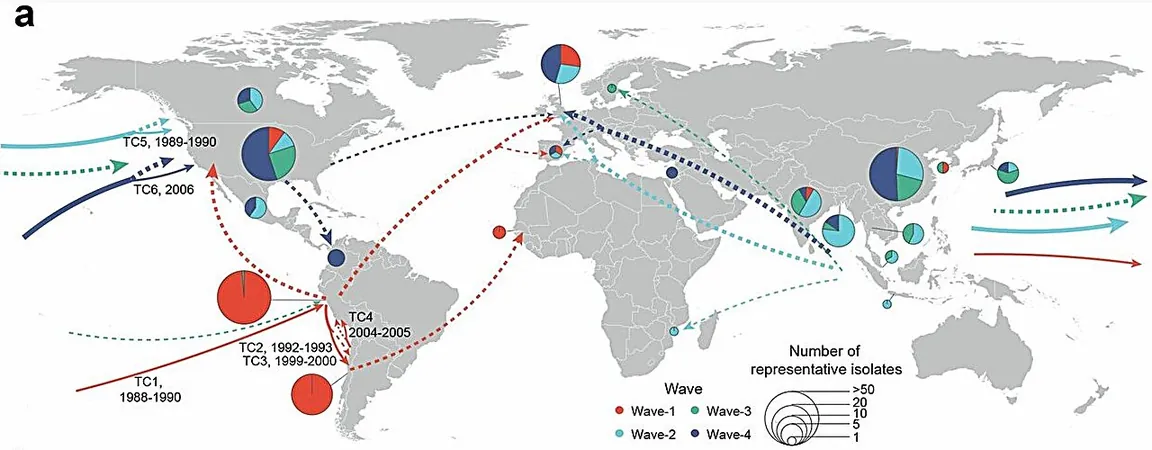
Why Losing Genes is the Key to Survival for a Deadly Pandemic Bacterium
2025-09-02
Author: Wei Ling
A Stunning Evolutionary Discovery
A groundbreaking study in *Nature Ecology & Evolution* reveals a shocking twist in evolutionary theory: sometimes, bacteria thrive not by acquiring new genes, but by shedding them. This finding redefines our understanding of how pathogens adapt and survive in challenging environments.
The Collaborative Research Team
Led by Jaime Martínez Urtaza from the Universitat Autònoma de Barcelona, this international team included experts from the Shanghai Institute of Immunity and Infection and Shanghai Jiao Tong University. Together, they explored the curious case of *Vibrio parahaemolyticus*, the bacteria notorious for seafood-related infections, especially as it interacts with human wounds.
The Evolutionary Journey of a Pandemic Bacterium
Concentrating on a pandemic strain that has caused significant outbreaks primarily in Asia since its identification in Japan in 1996, the researchers traced its spread to the U.S. and Latin America. In Spain, it led to a gastroenteritis outbreak in 2004, affecting 80 individuals.
A Familiar Wave of Change
When examined over time, different subtypes of this bacterium replaced one another at an alarming pace—much like how COVID-19 variants evolved. The dominant strain, named Wave-4, emerged as the major culprit behind human infections, raising a parallel with the pandemic's evolving variants.
The Surprising Advantage of Gene Loss
Instead of gaining new genes, Wave-4’s success stemmed from the loss of specific genes responsible for utilizing putrescine, a substance found in both the environment and the human gut. This gene loss conferred several advantages: stronger biofilms that enhance survival during environmental stress and improved ability to stick to human cells.
The Virulence Trade-Off Hypothesis
Interestingly, gene loss also led to less severe infections, supporting the virulence trade-off hypothesis. This suggests that pathogens that don't kill their hosts too quickly spread more effectively—an evolutionary balance exemplified by Wave-4.
Convergence Across Species
What’s truly remarkable is that similar patterns of gene loss were observed in other pathogens like *Vibrio cholerae* and *Escherichia coli*. This shows a phenomenon known as convergent evolution, where different species independently develop similar traits in response to comparable challenges.
Rethinking Evolution: Gene Loss as Strategy
Yang Chao, one of the researchers, emphasizes the importance of this discovery: "For a long time, gene loss was viewed as biological decay. Our study flips that notion on its head, demonstrating it can actually be a strategic evolutionary advantage. It wasn't about gaining mutations; it was about knowing what to lose at the right moment."
Unlocking a 30-Year Mystery
This study resolves a long-standing mystery about the global rise of *V. parahaemolyticus* over the past three decades. The researchers utilized an extensive genomic database comprising 8,600 genomes from around the world. Professor Martínez Urtaza hinted at future studies that could unveil how these pathogens manage transcontinental travel, building on this significant breakthrough.



 Brasil (PT)
Brasil (PT)
 Canada (EN)
Canada (EN)
 Chile (ES)
Chile (ES)
 Česko (CS)
Česko (CS)
 대한민국 (KO)
대한민국 (KO)
 España (ES)
España (ES)
 France (FR)
France (FR)
 Hong Kong (EN)
Hong Kong (EN)
 Italia (IT)
Italia (IT)
 日本 (JA)
日本 (JA)
 Magyarország (HU)
Magyarország (HU)
 Norge (NO)
Norge (NO)
 Polska (PL)
Polska (PL)
 Schweiz (DE)
Schweiz (DE)
 Singapore (EN)
Singapore (EN)
 Sverige (SV)
Sverige (SV)
 Suomi (FI)
Suomi (FI)
 Türkiye (TR)
Türkiye (TR)
 الإمارات العربية المتحدة (AR)
الإمارات العربية المتحدة (AR)